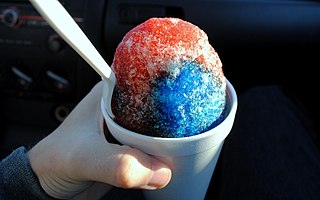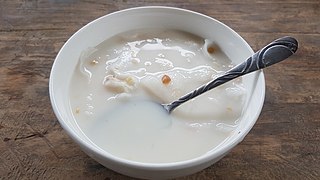
A sundae is an ice cream frozen dessert of American origin that typically consists of one or more scoops of ice cream topped with sauce or syrup and other toppings such as sprinkles, whipped cream, marshmallows, peanuts, maraschino cherries, or other fruits.
Knickerbocker or Knickerbockers may also refer to:

A knickerbocker glory is a layered ice cream sundae that is served in a large tall conical glass, and to be eaten with a distinctive long spoon, particularly in Great Britain and Ireland.

Filipino cuisine is composed of the cuisines of more than a hundred distinct ethnolinguistic groups found throughout the Philippine archipelago. A majority of mainstream Filipino dishes that comprise Filipino cuisine are from the food traditions of various ethnolinguistic groups and tribes of the archipelago, including the Ilocano, Pangasinan, Kapampangan, Tagalog, Bicolano, Visayan, Chavacano, and Maranao ethnolinguistic groups. The dishes associated with these groups evolved over the centuries from a largely indigenous base shared with maritime Southeast Asia with varied influences from Chinese, Spanish, and American cuisines, in line with the major waves of influence that had enriched the cultures of the archipelago, and adapted using indigenous ingredients to meet local preferences.

Halo-halo, also spelled haluhalo, Tagalog for "mixed", is a popular cold dessert in the Philippines made up of crushed ice, evaporated milk or coconut milk, and various ingredients including side dishes such as ube jam, sweetened kidney beans or garbanzo beans, coconut strips, sago, gulaman (agar), pinipig, boiled taro or soft yams in cubes, flan, slices or portions of fruit preserves and other root crop preserves. The dessert is topped with a scoop of ube ice cream. It is usually prepared in a tall clear glass and served with a long spoon. Halo-halo is considered to be the unofficial national dessert of the Philippines.

Shaved ice is a large family of ice-based desserts made of fine shavings of ice and sweet condiments or syrups. Usually, the syrup is added after the ice has been frozen and shaved—typically at the point of sale; however, flavoring can also be added before freezing. The dessert is consumed worldwide in various forms and ways. Shaved ice can also be mixed with large quantities of liquid to produce shaved ice drinks.

Maíz con hielo is a shaved ice dessert from the Philippines made with boiled corn kernels, sugar, and milk.

Buko pie, sometimes anglicized as coconut pie, is a traditional Filipino baked young coconut (malauhog) pie. It is considered a specialty in the city of Los Baños, Laguna located on the island of Luzon.

Sorbetes is a traditional ice cream originating from the Philippines and uniquely characterized by the use of coconut milk and/or carabao milk. Often pejoratively called "dirty ice cream", it is distinct from the similarly named sorbet and sherbet. It is traditionally peddled in colorful wooden pushcarts by street vendors called "sorbeteros". It is served in various flavors in small wafer or sugar cones and more recently, as a pandesal bread ice cream sandwich.

Mango float or crema de mangga is a Filipino icebox cake dessert made with layers of ladyfingers (broas) or graham crackers, whipped cream, condensed milk, and ripe carabao mangoes. It is chilled for a few hours before serving, though it can also be frozen to give it an ice cream-like consistency. It is a modern variant of the traditional Filipino crema de fruta cake. It is also known by various other names like mango refrigerator cake, mango graham float, mango royale, and mango icebox cake, among others. Crema de mangga is another version that additionally uses custard and gulaman (agar) or gelatin, as in the original crema de fruta.

Samalamig, also known as palamig, is a collective term for various Filipino sweet chilled beverages that usually include jelly-like ingredients. They come in various flavors, and are commonly sold by street vendors as refreshments. Typical ingredients of the drinks include gulaman (agar), sago pearls, kaong, tapioca pearls, nata de coco, and coconut. They are usually anglicized as pearl coolers or pearl and jelly coolers.

Minatamis na saging is a Filipino dessert made with chopped saba bananas cooked in a sweet syrup (arnibal) made with muscovado sugar and water. Some recipes also add a little bit of salt and pandan leaf or vanilla extract. Other ingredients can also be added like sweet potato, sago, or other fruits like jackfruit. It can be eaten on its own or added as an ingredient to other desserts. Adding the dessert over milk and shaved ice also results in another dessert known as saba con yelo.

Buko salad, usually anglicized as young coconut salad, is a Filipino fruit salad dessert made from strips of fresh young coconut (buko) with sweetened milk or cream and various other ingredients. It is one of the most popular and ubiquitous Filipino desserts served during celebrations and fiestas.

Lamaw, also known as buko lamaw, is a Filipino dessert or beverage made from scraped young coconut meat (buko) in coconut water with milk and sugar, and saltines or biscuits. Variations can add ingredients like peanuts, graham crackers, or orange-flavored softdrinks. Ice cubes are also commonly added to chill the dessert. It is usually made from freshly gathered coconuts, and is commonly served within the coconut shell itself. It originates from the Visayas and Visayan areas of Mindanao and is a traditional merienda for farmers working in the fields in rural areas.

Iskrambol, also known as ice scramble, is a Filipino frozen dessert made from shaved ice with banana extract and evaporated milk with sugar It is then topped with a variety of ingredients including powdered milk, marshmallows, strawberry syrup, chocolate syrup, pinipig, tapioca pearls, and sprinkles, among others. The regular banana extract flavored dessert is characteristically dyed pink while other flavors may be dyed accordingly.

Avocado and milk in ice is a traditional Filipino dessert or beverage made from avocado in milk and sugar.
















